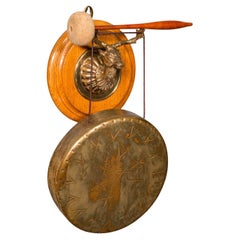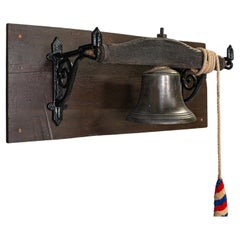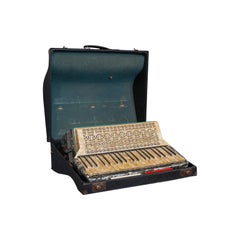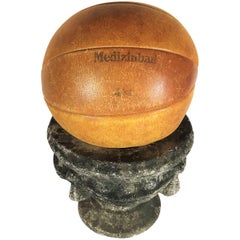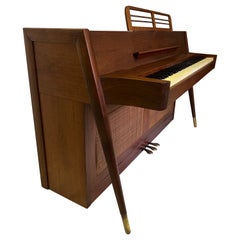London Fine Antiques Musical Instruments
to
3
3
1
1
1
1
1
3
2
2
2
1
3
2
1
1
3
3
3
Antique Shooting Lodge Dinner Gong, Victorian, Scottish Brass Chime, Oak, C.1880
Located in Hele, Devon, GB
This is a distinguished late Victorian dinner gong, evoking the grandeur of a Scottish Highland country estate, circa 1880. This superb antique chime fe...
Category
Antique 1880s Scottish Late Victorian Musical Instruments
Materials
Brass
Antique Mounted School Bell, English, Bronze, Oak, Pine, Georgian, Circa 1800
Located in Hele, Devon, GB
This is an antique mounted school bell. An English, bronze bell on oak and pine plinth, dating to the Georgian period, circa 1800.
Of superb proportion ...
Category
Antique Late 18th Century British Musical Instruments
Materials
Bronze
Vintage Piano Accordion, German, Squeezebox, Meinel and Herold, Dix Reeds
Located in Hele, Devon, GB
This is a vintage piano accordion. A German, pearloid squeezebox by Meinel and Herold with Dix reeds and carry case, dating to the mid-20th century, ci...
Category
Mid-20th Century German Musical Instruments
Materials
Brass
Related Items
Vintage Leather Medicine Ball, 1930s Germany
Located in Biebergemund, Hessen
The medicine ball is part of a big collection from the 1920s-1930s, the time of the first gym enthusiasts in Germany. The ball is handmade and filled with horse hair. All balls are i...
Category
Vintage 1920s German Bauhaus Sports Equipment and Memorabilia
Materials
Leather
Mid-Century Modern Baldwin Acrosonic Piano in Walnut and Caning, 1960's
By Baldwin Piano Company
Located in Charleston, SC
No description provided Mid-Century Modern Baldwin Acrosonic Piano in Walnut and Caning - 1960's This Mid-Century modern Acrosonic spinet piano made by Baldwin is very sought after and is an amazing addition to any home. It's signature Danish style modern tapered leg design and solid walnut wood cabinet...
Category
Mid-20th Century American Scandinavian Modern Musical Instruments
Materials
Brass
$8,000
H 36.25 in W 60 in D 27 in
Antique Asian Bronze buddhist bell Tibetan Meditation Prayer Ghanta Bell
Located in North Hollywood, CA
Antique Asian Bronze buddhist bell Tibetan Meditation Prayer Ghanta Bell.
Buddhist Tibetan Meditation Prayer Bell.
A Bronze ritual bell "DRILBU" in Tibetan or commonly known as "Ghan...
Category
Antique Early 1900s Tibetan Tibetan Religious Items
Materials
Bronze
Accordion by Sabatino Nocentini & Figli Made in Florence, Italy
Located in North Hollywood, CA
Antique Italian custom made accordion by Sabatino Nocentini Castiglion & Figli.
Antique pearl white accordion, Italian accordion with profuse inlay decoration, gorgeous hand made wit...
Category
Early 20th Century Italian Art Deco Musical Instruments
Materials
Abalone, Wood, Shell
Liberace Autographed Vintage Schoenhut Toy Grand Piano
By Schoenhut
Located in Hamilton, Ontario
Made by the renowned American toy manufacturer in approximately 1920, this wooden toy baby grand piano has been autographed in two places by the legendary Liberace. The piano shows o...
Category
Early 20th Century American Victorian Toys and Dolls
Materials
Brass
Poul Hennigsen Grand Piano
By Poul Henningsen
Located in Studio City, CA
Original Poul Hennigsen piano, circa 1930. Has been fully remastered and in beautiful condition. In 1930, the Danish creative genius, Poul Henningsen, reimagined what a piano could be when he created the PH Grand Piano...
Category
Vintage 1930s Danish Musical Instruments
Materials
Leather
A German 19th Century Louis XVI Style Burr Walnut Bechstein Concert Grand Piano
By Bechstein Piano Company
Located in Los Angeles, CA
A Very Fine German 19th Century Louis XVI Style Burr Walnut Bechstein Concert Grand Piano, Serial No. 5655. The beautifully crafted Grand piano, raised on three tapered barrel shaped legs, with an intricately carved ornate music desk and original keys. Circa: 1872.
Length: 80 inches (203.2 cm)
Width: 59 inches: (149.9 cm)
Height (top closed): 38 5/8 inches (98.1 cm)
C. Bechstein Pianofortefabrik
C. Bechstein Pianofortefabrik AG (also known as Bechstein) is a German manufacturer of pianos, established in 1853 by Carl Bechstein.
Before Bechstein
Young Carl Bechstein studied and worked in France and England as a piano craftsman, before he became an independent piano maker. His first pianos were made for other companies.
C. Bechstein
C. Bechstein piano factory was founded on 1 October 1853 by Carl Bechstein in Berlin, Germany.
Carl Bechstein set out to manufacture a piano able to withstand the great demands imposed on the instrument by the virtuosi of the time, such as Franz Liszt. In 1857, Hans von Bülow (Liszt's son-in-law) gave the first public performance on a Bechstein grand piano by performing Liszt's Piano Sonata in B minor in Berlin
By 1870, with endorsements from Franz Liszt and Hans von Bülow, Bechstein pianos had become a staple in many concert halls and private mansions. By that time three piano makers, all of which were founded in 1853, became established as the industry leaders across the world: Bechstein, Blüthner and Steinway & Sons.
In 1881 Bechstein began supplying pianos to Queen Victoria. A gilded art-case piano was delivered to Buckingham Palace, followed by several more Bechstein pianos to Windsor Castle and other royal residences. By January 1886 they were among the piano manufacturers holding a Royal Warrant as a supplier to the Queen. Several British embassies across the world acquired Bechstein pianos.
In 1885, Bechstein opened a branch in London, that eventually grew to become the largest showroom and dealership in Europe. By 1890 showrooms had been opened in Paris, Vienna, and Saint Petersburg. On 31 May 1901, Bechstein Hall, built at a cost of £100,000, was opened next to the company's London showroom at 36-40 Wigmore Street. Between 1901 and 1914, C. Bechstein was the largest piano dealership in London. At that time, Bechstein was patronized by the tsars of Russia, the royal families of Spain, Belgium, the Netherlands, Italy, Sweden, Norway, Austria and Denmark, and other royalty and aristocracy. The list of royal clients of Bechstein may be found on the soundboard of vintage Bechstein pianos made before the Second World War. The list is part of the original Bechstein trademark logo; it can be seen under the strings in the center of a piano's soundboard.
The signature of Carl Bechstein
The years from the 1870s through 1914 brought Bechstein their most dramatic increase in sales. In 1880 a second Bechstein factory was opened in Berlin, and the third factory was opened in 1897 in Berlin-Kreuzberg. Production reached 3,700 pianos annually in 1900, and 4,600 in 1910, making Bechstein the largest German manufacturer of high-end pianos. At that time, about three quarters of production went to international markets, especially Britain and the Commonwealth, and Russia.
Carl Bechstein died in 1900, and the Bechstein company continued to operate under the management of his sons.
Between 1900 and 1914 C. Bechstein was one of the leading piano makers in the world, employing 1,200 craftsmen and workers by 1913 and making five thousand pianos per year.
First World War
C. Bechstein suffered huge property losses in London, Paris, and St. Petersburg during World War I. The largest loss was in London. Although the company's position in the United Kingdom was initially unaffected, with the company still listed as holding a Royal Warrant in January 1915, Warrants to both King George V, and his wife Queen Mary were cancelled on 13 April 1915. Bechstein was not the only musical concern to be affected by growing anti-German sentiment: there were earlier attempts, led by William Boosey, to boycott German music altogether. In 1915, despite being a Baronet and Privy Counsellor, Sir Edgar Speyer, who was then funding the Proms, was forced to leave the country. Following the passing of the Trading with the Enemy Amendment Act 1916 the British arm of the company was wound-up on 5 June 1916, all Bechstein property, including the concert hall and showrooms full of pianos, were seized as "enemy property" and closed. In 1916 the hall was sold as alien property at auction to Debenhams for £56,500. It was renamed Wigmore Hall, and then re-opened under the new name in 1917. All 137 Bechstein pianos at the Bechstein showrooms were confiscated too, and became property of the new owner of the Hall. After a dispute with his brother, Edwin Bechstein left the company and was paid off.
Eventually the Bechstein factory resumed full-scale production during the 1920s. At that time, technical innovations and inventions of new materials and tools, as well as improvements in piano design and construction, had allowed Bechstein to become one of the leading piano makers again.
The most successful models were the updated "A"-185 and "B"-208 grand pianos. The upright pianos became more popular after the war, and C. Bechstein were successful with its upright pianos Model-8 and Model-9, both of which have been considered the finest upright pianos.
As the company was changed into a joint-stock company 1923, Edwin Bechstein and his wife Helene, bought themselves back into the company as shareholders.
In 1930 the company collaborated with German electrical goods manufacturer Siemens under Nobel laureate Walther Nernst to produce one of the first electric pianos...
Category
Antique 19th Century German Louis XVI Musical Instruments
Materials
Bronze
$49,850 Sale Price
33% Off
H 38.63 in W 80 in D 59 in
Chinoiserie Grand Piano From Rogers and Sons London
Located in Berlin, DE
Chinoiserie Grand Piano by Rogers and Sons London
The grand piano was manufactured according to the device number 1930.
The grand piano was sold in 1932 by Harrods London to a lady ...
Category
Vintage 1930s Musical Instruments
Materials
Wood
Louis XV Kingwood Grand Piano
By Carl Bechstein
Located in Queens, NY
French Louis XV-style ormolu mounted kingwood, tulipwood & parquetry grand piano (sgnd C.BECHSTEIN, numbered 20475 for the date 1888)
Category
Antique 19th Century French Musical Instruments
Materials
Ormolu, Brass
Antique Scottish Nautical Oak Ship's Wheel with Brass Accents
Located in Hamilton, Ontario
This antique ship's wheel was made by the MacTaggart, Scott & Co. of Edenborough, Scotland and dates to approximately 1900 and done in the period style. This ship's wheel is composed...
Category
Early 20th Century Scottish Late Victorian Nautical Objects
Materials
Brass
Steinway & Sons Concert Grand Piano
Located in SAINT-OUEN-SUR-SEINE, FR
This extraordinary concert grand piano with 88 keys was made by the prestigious firm Steinway & Sons around 1894. The case's decoration was entrust...
Category
Antique Late 19th Century French Louis XV Musical Instruments
Materials
Wood, Giltwood
Pierre-Paul Montagnac Modernist Piano
By Pierre-Paul Montagnac
Located in Philadelphia, PA
French Modernist Art Deco piano and bench by Pierre-Paul Montagnac, a variant of the model used in one of the luxe apartments, the Caen, on the great French oceanliner Normandie in 1935. Created in rosewood and sycamore, and carefully and correctly restored, including the fine Erard (#127208) instrument. 56” wide x 60” deep. Documented in numerous sources, including the July 1935 issue of Art et Decoration.
Pierre-Paul Montagnac
(1883-1961)
Born in Saint-Denis, France on 9 May 1883, Pierre-Paul Montagnac was equally talented as a fine artist and a decorative artist. He was educated in both disciplines, studying with Eugene Carriére as well as at the Académie de la Grande Chaumiére, both in Paris.
His inaugural exhibition was at the 1912 Salons – and at the 1920 Salon d’Automne he received a traveling scholarship. In 1918 he began working in the firm of André Mare and from 1922 collaborated with Maurice Dufrene at La Maîtrise, the famous design studio of Galeries Lafayette. From 1921 he exhibited at the Salons of la Société des Artistes Décorateurs, Salon des Architectes Modernes,
and internationally, in Barcelona and Leipzig. He designed suites on the grand French oceanliners, l’Atlantique, Normandie and Pasteur.
At the 1925 Paris International Exposition his work was in a standout class. At the 1937 Exhibition he organized the pavillion of the Artistes Decorateurs and personally won a Grand Prix. For the New York Exhibition in 1938, he was a member of the international jury, organized the group of Decorators, and, as architect, organized the exhibitions of jewelry and perfumes.
He became a member of the Society of Modern Architects and executed important and numerous architecture and decorating projects including the luxury apartments on the great French oceanliners l’Atlantique, Pasteur, and Normandie.
Vice President and then President of the Societe des Artistes Decorateurs from 1930-1938, he was also President of the Salon d’Automne and Vice President of the Committee of the Exhibition of Arts and Embellishments of Life; member of the steering committee of C.T.I. and Artistic Property, member of the Board of Directors of the Central Union of Decorative Arts. He was also an Officer of the Legion of Honor and received the Cross of War.
MONTAGNAC was the son of an engineer and he had a taste for geometry
and science that predisposed him to the rigors of architectural laws.
Multi-talented, he worked independently as a painter – who had
paintings acquired by the French government – while also working in
the related fields of architecture and decoration. His work included
homes, apartments, galleries, luxury shops, banks and the aforesaid
oceanliners.
As a designer/decorater, Montagnac had the taste for quality, luxurious
furniture, using precious woods, bronze extensions, ivory inlays, mother-of-pearl,
metal and coral. He advocated for a resolutely modern style and, free of all
pastiches, focused on beautiful cabinetry, the challenges of furniture design,
particularly from 1940 to 1945, captured all his attention.
The tireless activity of Montagnac, whose varied works are represented in
official museums and residences, was also recognized from a professional
and social point of view. He was a remarkable organizer, devoted to the
cause of art, to the defense of the trade and his colleagues. It was Montagnac
who, in 1939, with Anatole de Monzie, took the initiative to found the
ENTRAIDE to Artists (which provides support to talented young French artists).
MOBILIER ET DECORATION, September/October 1953
ERARD
An illustrious piano manufacturer, Sebastien Erard began building superior harpsichords in Paris in the mid-1700s, produced pianos for the French Court, and received a multitude of patents, many of which are still in use in piano manufacturing. Erard pianos were marketed as the finest pianos in the world and were owned by Queen Victoria, Franz Liszt, Chopin, Verdi, Ravel, and Felix Mendelssohn among many others. They continued to enjoy international success well into the 20th century. They were known for their unique sound quality, similar to the American square grand piano...
Category
Vintage 1930s French Art Deco Musical Instruments
Materials
Rosewood, Sycamore
